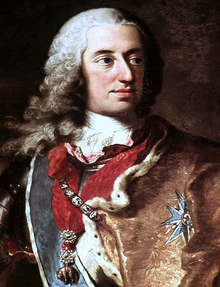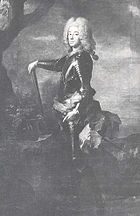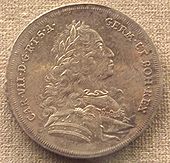- Charles VII, Holy Roman Emperor
-
Charles VII Holy Roman Emperor;
King of the Romans (King of Germany)Reign 24 January 1742 – 20 January 1745 (2 years, 362 days) Coronation 12 February 1742, Frankfurt Predecessor Charles VI Successor Francis I King of Bohemia Reign 1741–1743 Coronation 9 December 1741, Prague Predecessor Charles VI Successor Maria Theresa Duke of Bavaria, Prince Elector Reign 26 February 1726 – 20 January 1745 (18 years, 329 days) Predecessor Maximilian II Emanuel Successor Maximilian III Joseph Spouse Maria Amalia of Austria Issue Maria Antonia, Electress of Saxony
Maximilian III, Elector of Bavaria
Maria Anna Josepha, Margravine of Baden-Baden
Maria Josepha, Holy Roman EmpressHouse House of Wittelsbach Father Maximilian II Emanuel Mother Theresa Kunegunda Sobieska Born 6 August 1697
BrusselsDied 20 January 1745 (aged 47)
MunichBurial Munich Religion Roman Catholicism Charles VII Albert (6 August 1697 – 20 January 1745) a member of the Wittelsbach family, was Prince-elector of Bavaria from 1726 and Holy Roman Emperor from 24 January 1742 until his death in 1745. Charles was notably the only person not of the House of Habsburg to become emperor since the 15th century.
Contents
Early life and career
He was born in Brussels as the son of Maximilian II Emanuel, Elector of Bavaria, and Theresa Kunegunda Sobieska, and the grandson of Polish King John III Sobieski.
His family was split during the War of the Spanish Succession and was for many years under house arrest in Austria. Only in 1715 did the family become re-united. From 3 December 1715 until 24 August 1716 Charles visited Italy and in 1717 he joined the war of the Habsburgs against the Turks with Bavarian auxiliaries.
On 5 October 1722, Charles married Marie Amalie, Archduchess of Austria. Marie Amalie was a daughter of Joseph I, Holy Roman Emperor and his wife Princess Wilhelmina Amalia of Brunswick-Lüneburg. Her maternal grandfather was John Frederick, Duke of Brunswick-Lüneburg. In 1725 Charles Albert visited Versailles for the wedding of Louis XV and established a firm contact to France.
In 1726 when his father died Charles Albert became Prince-elector of the Holy Roman Empire and Duke of Bavaria. He managed to maintain good relations with his Habsburg relatives but also with France.
Holy Roman Emperor
Thaler coin of Charles VII, dated 1743
In continuance of the policy of his father Charles Albert aspired to an even higher rank. As son-in-law of Joseph I, Holy Roman Emperor, Charles Albert rejected the Pragmatic Sanction of 1713 and claimed the German territories of the Habsburg dynasty after the death of Charles VI in 1740. With the treaty of Nymphenburg concluded in July 1741, Charles Albert allied with France and Spain against Austria.
During the War of the Austrian Succession Charles Albert invaded Upper Austria in 1741 and planned to conquer Vienna but his allied French troops were redirected to Bohemia instead. So Charles Albert was crowned King of Bohemia in Prague (9 December 1741) when the Habsburgs were still not defeated. He was elected 'King of the Romans' on 24 January 1742, and took the title 'Holy Roman Emperor' upon his coronation on 12 February 1742. His brother Klemens August of Bavaria, archbishop and elector (Kurfürst) of Cologne, who mostly sided with the Austria Habsburg-Lorraine side during the Habsburg successions, cast his vote for him and personally crowned him emperor at Frankfurt. Charles VII was the second Wittelsbach Emperor after Louis IV and the first Wittelsbach King of the Romans since the rule of Rupert of Germany.
Shortly after the coronation most of Charles Albert's territories were overrun by the Austrians and Bavaria was occupied by the troops of Maria Theresa. Therefore the emperor fled Munich and resided for almost three years in the Palais Barckhaus in Frankfurt. He was made mockery of, since he was an emperor that neither controlled his own realm, nor was in effective control of the empire itself, though the institution of the Holy Roman Emperor has largely become symbolic in nature and powerless by this time. A popular saying about him in Latin was et Caesar et nihil, meaning "as well Emperor, as nothing", playing words on aut Caesar aut nihil, "either Emperor or nothing". Charles Albert's general Ignaz Felix Count of Törring-Jettenbach was compared with a drum, as people heard about him only when he was beaten.
But Charles VII tried to accentuate his government in Frankfurt with numerous legal acts such as the imperial privileg for the University of Erlangen in 1743 and the elevation of several members of the gentry to peers of the Empire. Charles Eugene, Duke of Württemberg was declared full age ahead of time in 1744. Alexander Ferdinand, 3rd Prince of Thurn and Taxis served as Principal Commissioner for Charles VII at the Perpetual Imperial Diet in Frankfurt am Main and in 1744 the Thurn and Taxis were appointed hereditary Postmaster General of the Imperial Reichspost.
The new commander of the Bavarian army, Friedrich Heinrich von Seckendorff fought Austria by a series of battles in 1743 and 1744. The new alliance with Frederick II of Prussia during the Second Silesian War finally forced the Austrian army to leave Bavaria and to retreat back into Bohemia. In October 1744 Charles VII reobtained Munich. Very gouty, he returned, only to die three months later. His brother Klemens August then again leaned toward Austria and also his son and successor Maximilian III Joseph made peace with Austria. With the Treaty of Füssen Austria recognized the legitimacy of Charles VII's election as Holy Roman Emperor.
Charles Albert is buried in the crypt of the Theatinerkirche in Munich.
Cultural legacy
Charles Albert's reign was the peak of the era of Bavarian rococo. François de Cuvilliés was appointed chief architect of the court and constructed also the Amalienburg. The Nymphenburg Palace was completed during his rule, the grand circle (the Schlossrondell) with baroque mansions, was constructed as initial point for a new city (Carlstadt) which was finally not realized. For the Munich Residence Charles Albert ordered to erect the Ancestral Gallery and the Ornate Rooms. He also ordered Cuvilliés to construct the Palais Holnstein for one of his mistress, the Countess Holnstein.
Among the most gifted Bavarian artists of his time, were Johann Michael Fischer, Cosmas Damian Asam and Egid Quirin Asam, Johann Michael Feuchtmayer, Matthäus Günther, Johann Baptist Straub and Johann Baptist Zimmermann.
Children
He and his wife Marie Amalie, Archduchess of Austria were parents of seven children:
- Maximiliane, Princess of Bavaria (1723). Believed to have died young.
- Maria Antonia, Princess of Bavaria (18 July 1724 – 23 April 1780). Married Frederick Christian, Elector of Saxony.
- Therese Benedikta, Princess of Bavaria (6 December 1725 – 29 March 1743).
- Maximilian III, Elector of Bavaria (28 March 1727 – 30 December 1777).
- Joseph Ludvig Leo, Prince of Bavaria (25 August 1728 – 2 December 1733).
- Maria Anna Josepha, Princess of Bavaria (7 August 1734 – 7 May 1776). Married Ludwig Georg Simpert, Margrave of Baden-Baden.
- Maria Josepha, Princess of Bavaria ( 30 March 1739 – 28 May 1767). Married Joseph II, Holy Roman Emperor.
Illegitimate children
Charles Albert and his mistress Sophie Caroline von Ingelheim had a son:
- Franz Ludwig Count of Holnstein (1723–1780) ∞ Anna Marie zu Löwenfeld (1735–1783), daughter of Clemens August of Bavaria
Titles
Charles VII, by the grace of God elected Holy Roman Emperor, forever August, King in Germany and of Bohemia, Duke in the Upper and Lower Bavaria as well as the Upper Palatinate, Count-Palatine of the Rhine, Archduke of Austria, Prince-Elector of the Holy Roman Empire, Landgrave of Leuchtenberg, etc. etc.
Ancestors
Ancestors of Charles VII, Holy Roman Emperor 16. William V, Duke of Bavaria 8. Maximilian I, Elector of Bavaria 17. Renata of Lorraine 4. Ferdinand Maria, Elector of Bavaria 18. Ferdinand II, Holy Roman Emperor 9. Maria Anna of Austria 19. Maria Anna of Bavaria 2. Maximilian II Emanuel, Elector of Bavaria 20. Charles Emmanuel I, Duke of Savoy 10. Victor Amadeus I, Duke of Savoy 21. Catherine Micaela of Spain 5. Henriette Adelaide of Savoy 22. Henry IV of France 11. Christine Marie of France 23. Marie de' Medici 1. Charles VII, Holy Roman Emperor 24. Marek Sobieski 12. Jakub Sobieski 25. Jadwiga Snopkowska 6. John III Sobieski 26. Jan Daniłowicz 13. Zofia Teofillia Daniłowicz 27. Zofia Żółkiewska 3. Teresa Kunegunda Sobieska 28. Antoine de La Grange d'Arquien 14. Henri Albert de La Grange d'Arquien 29. Anne d'Ancienville 7. Marie Casimire Louise de la Grange d'Arquien 30. 15. Françoise de la Châtre 31. See also
- Kings of Germany family tree. He was related to every other king of Germany.
- War of the Austrian Succession
- War of the Bavarian Succession
External links
 Media related to Charles VII, Holy Roman Emperor at Wikimedia CommonsCharles VII, Holy Roman EmperorBorn: 6 August 1697 Died: 20 January 1745
Media related to Charles VII, Holy Roman Emperor at Wikimedia CommonsCharles VII, Holy Roman EmperorBorn: 6 August 1697 Died: 20 January 1745Regnal titles Preceded by
Maximilian II EmanuelElector of Bavaria
1726-1745Succeeded by
Maximilian III JosephPreceded by
Maria TheresaKing of Bohemia
1741-1743Succeeded by
Maria TheresaPreceded by
Charles VIHoly Roman Emperor
German King
(formally King of the Romans)
1742-1745Succeeded by
Francis IMaximilian I (1623-1651) · Ferdinand Maria (1651-1679) · Maximilian II Emanuel (1679-1726) · Charles Albert (1726-1745) · Maximilian III Joseph (1745–1777) · Charles Theodore (1777-1799) · Maximillian IV (1799-1805)Monarchs of Germany Eastern Francia (843–918) 
Saxon Kingdom (919–62) Kingdom of Germany
in the Holy Roman Empire
(962–1806)Otto I • Otto II • Otto III • Henry II • Conrad II • Henry III • Henry IV • Henry V • Lothair III • Conrad III • Frederick I • Henry VI • Philip • Otto IV • Frederick II • Conrad IV • Rudolf I • Adolf • Albert I • Henry VII • Louis IV • Charles IV • Wenceslaus • Rupert • Sigismund • Albert II • Frederick III • Maximilian I • Charles V • Ferdinand I • Maximilian II • Rudolph II • Matthias • Ferdinand II • Ferdinand III • Leopold I • Joseph I • Charles VI • Charles VII • Francis I • Joseph II • Leopold II • Francis IIConfederation of the Rhine (1806–1813) Napoleon IGerman Confederation (1815–1848) German Empire (1849) Frederick William IV (emperor-elect)German Confederation (1850–1866) North German Confederation (1867–1871) German Empire (1871–1918) Categories:- Holy Roman Emperors
- German kings
- Bohemian monarchs
- House of Wittelsbach
- Dukes of Bavaria
- Pretenders to the Bohemian throne
- Knights of the Golden Fleece
- Roman Catholic monarchs
- German military personnel of the War of the Austrian Succession
- 1697 births
- 1745 deaths
- People from Brussels
- Grand Masters of the Royal Order of Saint George for the Defense of the Immaculate Conception
- Burials at the Theatine Church, Munich
- Imperial vicars
- Electors of Bavaria
- Electoral Princes of Bavaria
Wikimedia Foundation. 2010.







